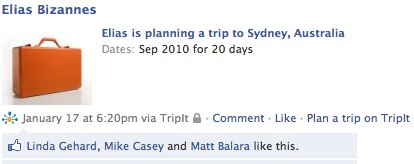Around 9.15pm last night after my first rugby training for the year (and in America), I sat down at the bus stop right by the football field, to catch a bus home. Playing on my iPhone, I noticed a woman walk past me and then run back. That’s weird I thought and it raised my awareness levels. Then, I noticed a hooded black kid approach the bus shelter from the back and entering from the left. I watched him turn and saw his arm raise with his jacket covering his hand. A second later, he pointed a gun right into the left temple of my head and mumbled: “ok man, hand it over”.
Luckily, I got away with my wallet, phone – and life – in tact. (I stood up, roared abuse at him, and he ran away – don’t ask why I did what I did, but it worked!) Minutes later, I shared the news on my Facebook account:
And I received a flood of comments, phone-calls and text messages over the next 24 hours. No ‘likes’ however.
The like feature
Friendfeed, a startup Facebook acquired last year, pioneered social media in the way people could collaborate and share information. One of its most brilliant innovations was the ‘like’ feature – the ability for a user reading something, to acknowledge the content being shared by another user. Rating systems are a hard thing to get right, and its been said by YouTube that the standard five-star rating systems are actually not quite five stars. Friendfeed’s simple but elegant approach took a life of its own as a rating mechanism and more. Facebook implemented the feature, and I’ve been observing how my social circle have reacted to it – and I’ve been startled at the way its been used. Just like the unique culture Friendfeed built, encouraged by this simple ‘liking’ activity, so to has Facebook’s users developed a unique kinds of behaviour. I’d argue its become one of the key forms of activity on the site.
So congrats Facebook – you copied a feature and your users love it. Now how about you evolve this remarkably simple form of communication, which has become a powerful way to have people share information (as it flags value, quantifies a kind of engagement and adds an additional level of communication to the originating message). How about a dislike feature? Do you think people would use that?
My friend Marty responded to my gun incident with the following:
And he wasn’t the only one. My Friend Kyle, who responded first, said:
Despite being an engaging piece of content and popping up on my friend’s homescreens, there were no ‘likes’. It just didn’t seem appropriate. But just like when you can’t speak a foreign language fluently but want to communicate a message, the lack of this feature prevented additional communication.
Social media is here to stay and is having a remarkable impact on our word. If by definition its about connecting people and communicating with each other, let’s evolve the way they can express their thoughts beyond simply text. It’s going to lead to a more interactive, engaging, and a far richer experience. This post may seem trivial because it’s like advocating we create a new word to communicate a frivolous concept, but like language, we gain a type of richness in the diversity we have to express ourselves.




